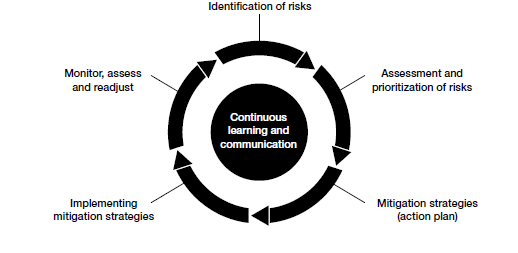The approach to risk management at Telefilm is largely based on the Treasury Board Secretariat document entitled Integrated Risk Management Framework 9 , as well as recommendations made during annual audits of management processes and more recently, the results of the Special Examination which took place this year.
Governance framework
The Board is ultimately responsible for managing corporate risk at Telefilm. The Board approves risk thresholds as well as corporate-wide risk management plans, and ensures that the organization optimizes risk management by balancing the management of threats with the management of opportunities, according to approved levels of risk tolerance.
The Management Committee (MC) is responsible for monitoring the risk management process and for keeping the Board informed of its findings. The MC is supported by a risk management committee composed of senior managers from operations, finance and administration. These managers are responsible for implementing risk management processes, appropriately distributing information regarding risk, and continually raising awareness of risk management practices. The governance framework will be reviewed and improved this coming fiscal year by formally integrating the risk management committee throughout the organization and by providing quarterly management reports to the MC and the Board.
Integrated risk management
Integrated risk management consists of several steps, as outlined in the following diagram. Once a year, the risk management committee identifies and assesses the risks most likely to affect the continuous running of operations. It also forecasts the consequences of risks based on their probability of occurrence and their impact on Telefilm. Risk assessment also takes account of existing control mechanisms and their effectiveness in mitigating risk. The results of this exercise serve to develop a risk mitigation strategy and an action plan, which is approved by the MC. The action plan is then communicated throughout the organization to ensure that risk-mitigation efforts are applied consistently by all departments. The plan is reviewed on a quarterly basis to assess its progress and effectiveness, and to ensure that resources are optimally allocated according to the priorities and new risks that have been identified over the course of the year.

Identifying risks
Corporate risks can be strategic, financial, organizational or operational in nature. At Telefilm, risk is distributed as follows:
Types of risk

The process of identifying risks uses Telefilm’s strategic objectives as a guide, so that risk management is aligned with overall business goals.
Risks based on strategic objectives

Risk mitigation strategies
Telefilm uses the same objective-based approach when implementing mitigation controls and procedures. The following are some of the major risks Telefilm faces, along with the mitigation strategies applied:
| Strategic objectives | Major risks | Mitigation strategies |
|---|---|---|
| Building audiences |
|
|
| Building industry capacity |
|
|
| A responsible administrator |
|
|



